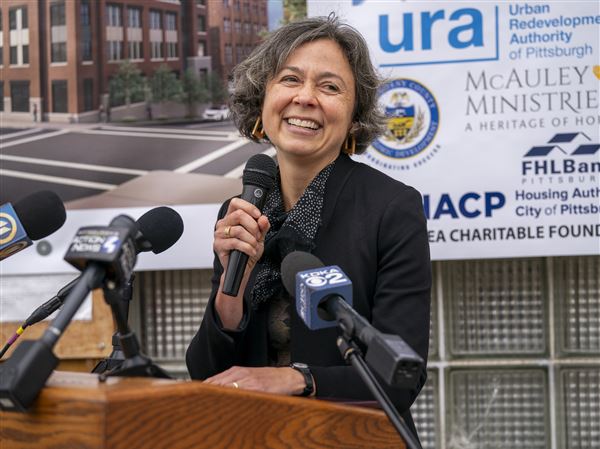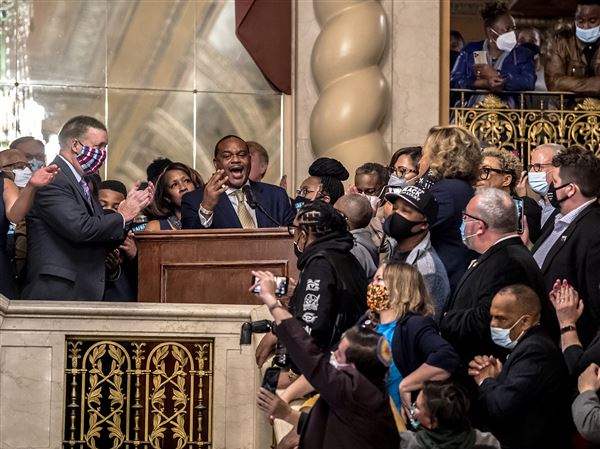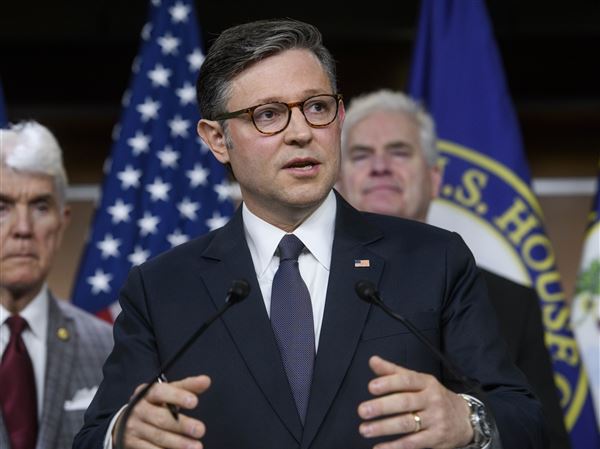A couple of the robots -- toy-sized, four-wheeled lunar-rover-like machines -- ran mazes, backing and turning when they touched walls.
Others followed squiggly lines of tape on tables, using light sensors to tell black tape from white table. The light sensors helped others stay away from the table's edges, backing away and turning when they detected the abyss.
One robot worked its way slowly through a three-pylon slalom course, using ultrasound to find the pylons and make turns. Another worked through a simpler slalom course, then found a ball and pushed it off the table.
And one used ultrasound to find balls, a snout-like light sensor to sniff out red ones from blue ones and a little grabber to scoop up the blue ones.
"That robot was not in the manual," instructor Dave Richardson announced after that demonstration. "The design was all in their heads."
In fact, the robots were very different, but they had one thing in common -- all were built and programmed by 45 Beaver County middle school students during a two-week robotics academy that wrapped up with a demonstration Friday.
The academy, organized by the Beaver Valley Intermediate Unit, assembled the students at the Community College of Beaver County, gave them robot kits, a series of challenges and four instructors, and turned them loose.
The results were surprising.
"We thought it would take them all day to build" the basic robots, Mr. Richardson said. "It took them an hour."
And he said one group came up with an innovation the creators of the kit had not built in.
"We do a line-tracking program that it just wiggles all the way up," he said, with the robot changing direction each time a light sensor crosses from the black line onto the white background. "Well, these kids figured out that if you look at the problem differently, instead of light-dark, light-dark, if you just went along the side" it would make for a smoother journey.
"These kids innovated, and came up with a solution that even the adults and the designers downtown hadn't thought of."
The children worked in groups of two and occasionally three or four, mounting sensors on their toy-sized, four-wheeled Lego Mindstorm robots and trying to program them to perform preset tasks. There was a battle-bots competition, with the various creations trying to flip their opponents, push them off the table or otherwise disable them. And many of the groups put together PowerPoint presentations for the final exhibition.
"The thing that really surprised me is the students are that young and can do PowerPoint and I can't," instructor John Fantone said, laughing.
The kids worked in a large open space in CCBC's Student Union building, and all the instructors were impressed how they collaborated, sharing both engineering and programming solutions.
"If somebody said 'hey, I need a wheel,' somebody else said, 'oh, I have an extra one,'" instructor Trece Kovach said. "To get 45 kids from all different schools and from such diverse backgrounds into a room and to share like that is unreal."
Anna Mae Paladina, program specialist for the intermediate unit, said the organization decided to pursue a robotics summer school instead of one on the arts this year partly because the Lincoln Park Performing Arts Center in Midland is now supporting arts education.
Ms. Paladina contacted Robin Shoop of Carnegie-Mellon University's Robotics Academy, which has robot kits and curricula designed for high school students, supported by grants from the National Science Foundation and Heinz Endowments.
The Robotics Academy became a partner, providing the materials and providing Mr. Richardson. The intermediate unit obtained a $6,000 grant from the state Department of Education and provided Mr. Fantone, Ms. Kovach and fellow instructor Greg Mason.
Mr. Richardson has organized regional robotics competitions and headed a robotics project at Butler County Community College, though he is leaving the area to return to his Cleveland roots.
Mr. Fantone taught electronics and robotics for 15 years at CCBC and the Beaver vo-tech school. Ms. Kovach teaches business technology in the New Brighton School District, and Mr. Mason teaches physics and math at Rochester Area High School and is a battlebots club sponsor for the Southwestern PA Battlebots IQ Challenge.
"If this area is really going to be Robo-burgh, going to really be a place where you come for robotics, this is the first step that you really need to take," Mr. Richardson said.
It is certainly a step the intermediate unit, which provides educational services to its member districts, expects to take again. Ms. Paladina said they hope to use this summer's experience to tweak the program and present it again in the future.
It seemed clear, though, that even as a trial run, it was a good experience for the students.
"I think it was a great opportunity for kids to learn during the summer, especially to learn something like robotics, which is the next wave of the future," Mr. Mason said.
He said the biggest surprise for him was how motivated and interested the children were.
"The first day they were just champing at the bit to get going with the program," he said, noting that it really made his job easy. "I didn't have to do a lot, just kind of let them go and they learned on their own for the four or five hours they were here each day."
One twist was that the 13 girls in the program were grouped together under Ms. Kovach, on the basis that boys tend to be more aggressive and assertive when it comes to robotics, and too often take over when the groups are mixed.
Ms. Kovach and Mr. Richardson said the difference was most stark when it came to battle-bots -- almost all of the boys were intensely interested; almost none of the girls were interested at all.
"Whereas guys think 'fight, fight, fight,' women are thinking, 'wait a minute, I can use this to do X, Y and Z,'" Mr. Richardson said.
Ms. Kovach proudly claimed that her girls did the best job overall in the projects -- but also did it in ways sometimes that might make boys roll their eyes.
"I had one girl take masking tape and give her robot hair," she said. "I said, 'You go!' It was great."
First Published: August 2, 2007, 6:30 p.m.

















